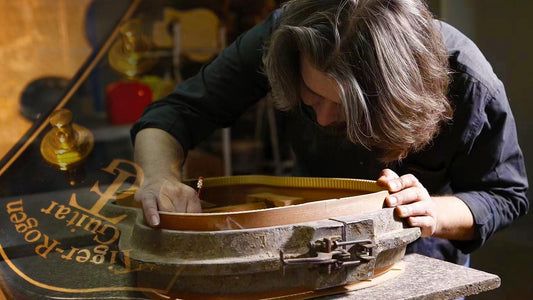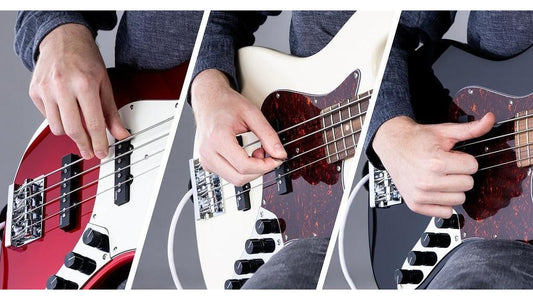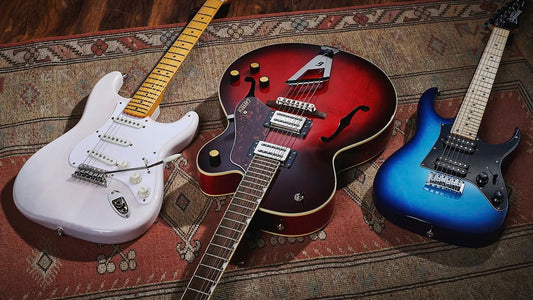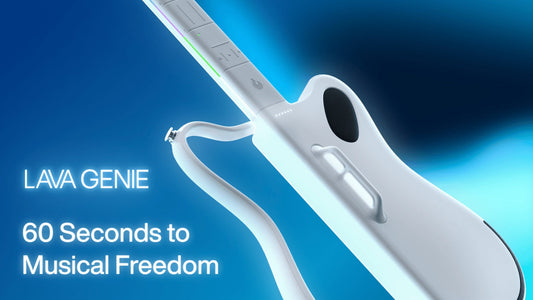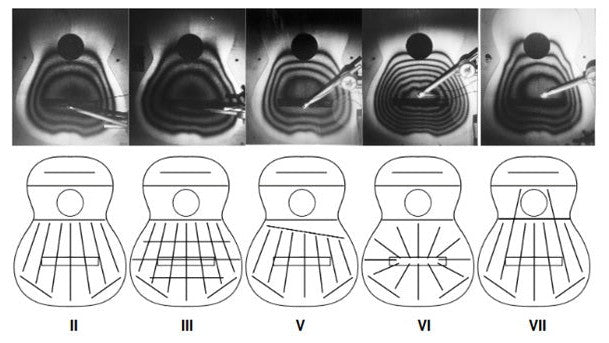
Những Nghiên Cứu Khoa Học Về Thanh Giằng Đàn Guitar - Bracing
Một trong những điều đầu tiên các tay chơi đàn thường làm khi đánh giá chất lượng guitar chính là kiểm định loại gỗ. Bên cạnh đó, vẫn có một số ít những người hiểu được tầm quan trọng của bracing guitar.
Bracing được hiểu là những thanh gỗ được gắn ở mặt trong chiếc đàn, giúp gia cố phần đầu - nơi rung lên theo từng nhịp đàn, và làm tròn âm thanh tổng của cả cây đàn. Bracing tiếng Việt được gọi là "thanh giằng".
Có rất nhiều các kiểu bracing khác nhau được sử dụng khi chế tác guitar, nhưng nhìn chung, chúng đều phải đảm bảo sự cân bằng: gia cố phần đầu đàn một cách vừa phải sao cho không làm chết các sóng dao động âm thanh. Sự kết hợp của gỗ, soundboard và tấm chống đỡ sẽ làm nổi bật 1 vài nét hài hoà trong thiết kế.
Hơn 4 thập kỷ qua, Tiến sĩ Bernard Richardson, ĐH Cardiff đã nghiên cứu chuyên sâu về cách rung động của đầu đàn và sự ảnh hưởng của bracing đến điều đó. “Điều quan trọng của thiết kế soundboard chính là: sử dụng một tấm chống đỡ để có thể đạt được độ bền tối thiểu cần thiết, nhằm ngăn chặn sự biến dạng của dây kéo trên ngựa (và làm xoắn soundboard). Ngoài ra cung cấp được độ cứng tối thiểu cần thiết cho hoạt động âm bình thường, nhưng đồng thời giữ cho khối lượng dao động của tấm ở mức nhỏ nhất. Đó chính là nghệ thuật chế tác đàn - đạt được sự cân bằng giữa độ cứng và độ nhẹ”.
Nghiên cứu của Tiến sĩ Richardson giúp cung cấp kiến thức mới chuyên sâu cho các nghệ nhân chế tác đàn. Tuy nhiên, những kiến thức này cũng giúp những người chơi guitar hiểu rõ hơn về nhạc cụ của họ, và bày tỏ niềm thông cảm đối với những khó khăn của thợ làm đàn gặp phải trong quá trình chế tác guitar.
THANH GIẰNG GUITAR CLASSIC HÌNH DẺ QUẠT (FAN BRACING)
Theo nghệ nhân chế tác đàn Jose L.Romanillos, Antonio Torres - người đã đặt nền tảng cho thiết kế guitar hiện đại vào cuối thế kỷ 19, sử dụng hệ thống 3 tấm chống đỡ.
Thiết kế đẹp nhất của Torres có 7 thanh chống hướng tâm theo hình dạng cánh quạt (với 2 chiếc nằm chéo), trong khi 2 thiết kế khác của ông chỉ có 5 thanh chống. Những nghệ nhân chế tác đàn nổi tiếng khác đã từng thiết kế guitar với 4, 6, 7, 8, 9 hoặc 11 thanh chống.
Dưới đây là hình ảnh của 1 cây guitar Yamaha C40 dành cho người mới chơi, có khung hình cánh quạt với 4 thanh chống nằm ở phía dưới mỗi bên hông. Hình ảnh ngay phía dưới tiếp theo là chiếc Artist Guitar CL44PK AM, với 5 thanh chống.


Thứ mà chúng ta không thể thấy trong 2 bức ảnh trên chính là độ dày của soundboard và độ cứng, nhằm đánh giá sự ảnh hưởng của hệ thống chống đỡ. Đây chính là điều tiến sĩ Richardson đã thử nghiệm trên vài soundboard khác nhau, sử dụng những thiết bị tiên tiến.
THANH GIẰNG GUITAR FLAMENCO HÌNH DẺ QUẠT (FAN BRACING)
Chúng ta có thể nhận thấy rõ những cây đàn làm từ gỗ thông trắng có chất lượng tốt hơn so với hai cây đàn đã đề cập bên trên. Tuy vậy, đây không phải là 1 phép so sánh khập khiễng chỉ vì cây guitar Rafael Romeo có giá cao hơn 2 cây còn lại.

Cây đàn vẫn có viền hình quạt và dây nylon, nhưng có tới 7 thanh chống đỡ. Bên cạnh đó, những cây guitar khác được tạo ra bởi Santo Hernandez, Domingo Esteso, và Marcelo Barbero đều có soundboard trong suốt, siêu nhẹ, cũng được hỗ trợ bởi 7 thanh chống đỡ theo phong cách flamenco.
Theo Jose L.Romanillos: “Kỹ thuật này rất quan trọng đối với chất lượng bộ gõ cần có của 1 chiếc flamenco guitar lý tưởng, nhằm tránh hiện tượng vọng lại của âm thanh từ soundboard đến các dây đàn. Để có thể đạt được điều trên, những nghệ nhân chế tác guitar flamenco phải thiết kế cây đàn sao cho âm thanh của note phải xảy ra và kết thúc đồng thời với cử chi gảy đàn của người chơi.”
THANH GIẰNG GUITAR ACOUSTIC HÌNH CHỮ X (X BRACING)
Do guitar acoustic sử dụng dây thép (steel) nên gây ra lực tác động mạnh lên ngựa cũng như mặt top của cây đàn. Thanh giằng bên trong phải vừa có thể giữ chắc khỏi tác động kéo của dây, vừa giúp âm thanh có độ cộng hưởng như ý. Và X Bracing được đánh giá là hiệu quả hữu hiệu cho acoustic guitar. Khung chữ X được phát minh bởi Martin Guitar.
Kỹ sư Luthier Trevor Gore cho rằng, thiết kế khung chữ X của một cây đàn guitar cỡ đại giúp tạo ra 1 hiệu ứng vô cùng hấp dẫn: bass mạnh nhưng âm bổng cao, với 1 dải trung trầm sâu lắng. Thiết kế này còn rất phù hợp đối với dòng nhạc bluegrass bởi nó tạo khoảng trống cho âm thanh.
Ngoài ra, những nghệ sĩ guitar sử dụng kỹ thuật strumming cũng có thể cân nhắc thiết kế này, bởi nếu bạn có dải trung đầy đủ trên một cây đàn guitar chơi strumming, cây đàn đó thường rất khó nghe. "Các tay chơi guitar vẫn cần nhận thức được rằng mỗi chiếc đàn 1 là bản thể riêng biệt và sự ảnh hưởng của 1 yếu tố lên âm thanh, ví dụ như thiết kế viền, có thể được cân bằng bởi yếu tố khác.
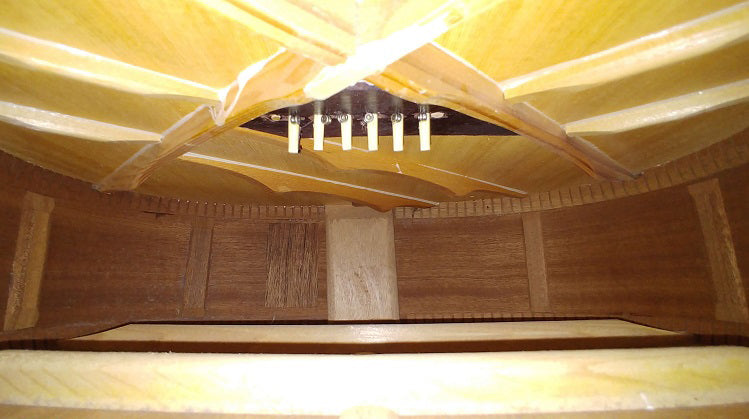
Hình ảnh chân thật về sự rung của soundboard được quay bằng camera
Chúng ta có thể đánh giá được chất lượng âm thanh của một cây đàn bằng cách xem xét phản xạ của thùng đàn tác động lên dây. Trong đó, khung trong của đàn là yếu tố quan trọng nhất, bên cạnh chất lượng gỗ, kích cỡ và độ dày của soundboard.
Tiến sĩ Richardson tại nhóm âm học của Trường Vật lý và Thiên văn của Đại học Cardiff đã ghi hình lại phản ứng rung của thùng đàn các loại guitar khác nhau. Dù rằng chuyển động này là khó nắm bắt và phức tạp, chúng ta có thể bóc tách chúng thành các tần số cộng hưởng khác nhau hoặc các tần số mode. Đây là những tần số cụ thể nhằm khuếch đại chuyển động guitar.
Những hình ảnh dưới đây, từ bài báo năm 2002 “Đầu vào và các phép đo trường âm thanh của mười cây đàn guitar cổ điển” (Input admittance and sound field measurements of ten classical guitars), cho thấy năm thiết kế bảng âm phổ biến rung như thế nào ở chế độ cơ bản của chúng. Các điểm biểu đồ dao động tương tự như các đường đồng mức của bản đồ.
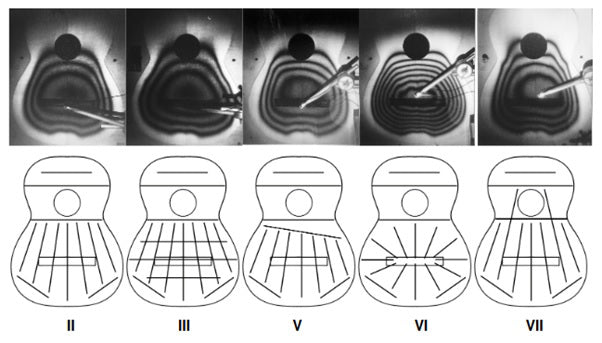
Soundboard II là thiết kế tiêu chuẩn của Torres; III: thiết kế lưới; V: thiết kế của Ramirez; VI: thiết kế xuyên tâm; và VII: thiết kế Torres mở rộng.
Đây là những khác biệt tinh tế nhưng quan trọng ảnh hưởng đến âm thanh theo những cách phức tạp.
Một trong những phát hiện thú vị nhất của nghiên cứu này là mỗi cây đàn guitar đều có đặc điểm riêng nhưng đều tạo ra giai điệu chất lượng tuỳ theo sở thích của những người chơi đàn.
Tiến sĩ Richardson cho rằng: “Không có một công thức cụ thể nào cho 1 chiếc đàn tốt, giống như rượu vang vậy, có rất nhiều các loại rượu đều tốt giống nhau nhưng lại cho những hương vị riêng. Và đương nhiên sẽ có những loại rượu tệ”.
Không một thiết kế thanh giằng nào có thể đảm bảo một kiểu phản hồi cụ thể - ngược lại, mọi thiết kế đều hướng đến sự cân bằng chính xác tổng thể giữa độ cứng và sự phân bố khối lượng của bản thân soundboard (mà cách chống rung giúp định hình).
Đàn Guitar là loại nhạc cụ phức tạp và hệ thống giằng bên trong chỉ là một yếu tố ảnh hưởng đến âm sắc và chất lượng tổng thể. Nhưng điều đáng xem xét là bên trong một cây đàn guitar có thể tiết lộ một số yếu tố cơ bản mà bên ngoài không thấy được.
